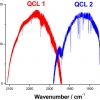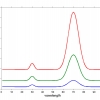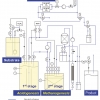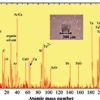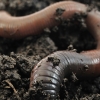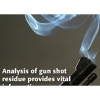This year the International Barcode of Life initiative (IBoL) plans to begin an ambitious programme to barcode the DNA of more than five million specimens representing at least 500,000 species in five years. Molecular barcodes exploit the fact that molecular sequences offer an independent method to identify a sample. Such molecular barcodes have widespread application in systematics, biodiversity, forensics and even food science. Molecular barcodes tend to be based upon DNA, which with the advent of new technologies offers a fast and efficient means of identification. Proteins too have been used in the past for molecular identification, most commonly exploiting the exquisite specificity of antibodies to discriminate targeted proteins. Recently the idea of using protein mass spectrometry to fingerprint samples has been used to target samples in which processing or decay has destroyed the DNA.
Articles and Columns
Pages
Christmas is a time of giving and it is with great pleasure that we are able to report the news that Dr Michael Heise, a friend of many years both personally and of this column, has recently been awarded the title of Honorary Professor at the University of Applied Sciences of South-Westphalia in Iserlohn, Germany.1 Mike has been regarded for a long time as an “Internationaler Experte für Infrarot-Spektroskopie”, as the Iserlohn University of Applied Sciences put it on their press release!
The growing use of Fourier transform infrared (FT-IR) spectroscopy as a tool for quality checking amongst other things foodstuffs, industrial products and pharmaceuticals begs the question of how this technology could be applied to quantifying aspects of the internal environment of living organisms. To do this requires knowledge of the types of exudates and secretions that organisms produce. Usefully, all organisms do this and, as such, the potential to look into the internal environment of living organisms is now being realised. My particular interest is in molluscan mucus as a measure of both species identification and environmental monitoring. This interest has led onto considerations of how monitoring of mucus could be used in other organisms, particularly humans. This article hopes to provide a brief current overview of the use of FT-IR spectroscopy in the investigation of mucus from a variety of organisms.
The intense development of industrial and urban areas in the absence of accurate measures to control pollution sources is often the cause of several environmental problems: dispersed and undetected chemical waste problems, in particular trace elements such as heavy metals, may cause freshwater, soil and water-table contamination. Such events are rarely detectable by sporadic analyses on water samples, since trace element concentrations are often below the instrumental detection limits and/or quickly change in space and time.
John Hammond
Starna Scientific Ltd, 52–54 Fowler Road, Hainault Business Park, Hainault, Essex, IG6 3UT, UK
The Irish writer George Bernard Shaw once said: “England and America are two countries divided by a common language”. Whilst this statement generally refers to the over 4000 words in everyday use in the United States that are not in British English, in the scientific world “is it metre or meter”, or for spectroscopists, nanometre or nanometer?
Often, chemists are interested in the most efficient way of converting our starting materials into the desired product. A huge number of reactions proceed via the production of intermediate species which are usually short-lived and difficult to detect. Such intermediates are considered to be of great importance because it is their reactivity which can determine the outcome of a reaction and, hence, the efficiency with which the final product is made. This can have widespread importance across the whole of chemistry, ranging from pharmaceutical and organic synthesis to catalysis and materials chemistry.
This column has been developed from two recent publications by Tom Fearn. "The effect of spectral pre-treatments on interpretation” and "On the geometry of SNV and MSC"
In urban environments, where the majority of the human population lives, air pollution is a major threat to human health. In many countries and regions of the world, this has led to the implementation of regulations to control the emissions of air pollutants and limits for the allowed concentrations of different types of air pollutants. The limits are set at levels at which harm to the health may occur if the limits are exceeded. One of these pollutants is aerosol particles. In most cases, the environmental quality standards limit is set to a certain mass concentration of particles of a certain size.
A.N. Davies,a H.M. Heiseb and D.F. Ihrigc
aProfessor, SERC, University of Glamorgan, UK, Director, ALIS Ltd, and ALIS GmbH—Analytical Laboratory Informatics Solutions
bISAS—Institute for Analytical Sciences at Dortmund University of Technology, Bunsen-Kirchhoff-Str. 11, D-44139 Dortmund, Germany
cUniversity of Applied Sciences of South-Westphalia, Frauenstuhlweg 31, D-58644 Iserlohn, Germany
The 12th Biological and Environmental Reference Material symposium (BERM 12) is now over: held at Keble College, Oxford, UK, from 7 to 10 July 2009 it was, based on the feedback received, a resounding success, both scientifically and socially. The weather was perfect and the setting magnificent
An NMR tour of Mediterranean anise-flavoured alcoholic beverages.
The enormous variability in the concentration of plant toxins and nutrients in trees, shrubs and forbs requires extensive sampling to accurately represent the nutritional and toxicological landscape and this is an ideal application for quantitative near infrared (NIR) reflectance spectroscopy. The speed of NIR spectroscopy analysis makes it ideally suited to environmental monitoring and ecological investigations where large numbers of replicates need to be measured. Several recent studies, including one focused on underwater plants on the Great Barrier Reef and the second in Bolivian rainforests, show the power of NIR spectroscopy to address large-scale variability in plant–animal interactions.
The purpose of this article is to give a comparative description of two methods applying ion-beam sputtering in materials research: secondary ion and neutral mass spectrometries (SIMS and SNMS). We shall illustrate the application of the latter by reports on a compositional analysis of perovskite oxides and on an investigation of nanoscaled multilayer structures.
This article shows that MALDI high resolution mass spectrometry demonstrated directly that Hev b 6 and Hev b 1, and also truncated forms thereof, are present on the inner surface of medical NRL gloves. The speed and high accuracy of the applied method and instrumentation makes the detection of surface associated proteins feasible without any prior protein extraction procedure (in situ localisation).
This column is about “Computational Chemistry”.
The definition of Chemometrics is: “The application of mathematical and statistical techniques to extract information from complex data”. You might think that it is computational chemistry, but I suspect that the majority of people who use computational chemistry have little knowledge or interest in chemometrics and similarly most chemometricians have little interest in computational chemistry. Computational chemistry uses the results of theoretical chemistry, incorporated into efficient computer programs, to calculate the structures and properties of molecules and solids. It seems that these two topics are conducted by two groups on parallel tracks, which, of course, never meet. This could be a mistake.
This article highlights the versatility of the developed methodology for the measurement of arsenic species in a range of materials from Devon Great Consols (DGC), one of many former mining sites in the south- west of England.
The summer of 2009 has been notable for two metrologically significant events: the annual meeting of the ISO REMCO Committee and the 12th BERM Symposium, neither of which has ever been held before in the UK. It is a massive credit to LGC that they were able to host both meetings and succeeded in making the BERM Meeting one of the best ever! In this column John Hammond, the UK Industry Delegate to ISO/REMCO, reports on the proceedings and decisions of the meeting. I’ll be reporting on BERM 12 in the next column and also explaining the relationship between the UK Reference Materials Working Group, the BSI and ISO/REMCO.
Spectroscopy plays a vital role in the forensic scientist’s task to analyse crime scene evidence. A new and emerging technique within the forensic field is X-ray fluorescence (XRF) microscopy.
This article outlines the use of the DOSY NMR method applied to drug analysis and screening for counterfeit drugs or fake herbal medicines
Interest in Raman spectroscopy as an analytical technique that can be applied in a wide variety of fields continues to increase. The main reason for this interest is that no special sample preparation is required. However, the Raman signal is typically very weak, with only one in every 106–108 photons being scattered. This has driven the development of several enhancement techniques, e.g. Resonance Raman (RR), Surface Enhanced Raman Spectroscopy (SERS) and Surface Enhanced Resonance Raman Spectroscopy (SERRS), which can be used for dilute samples.





